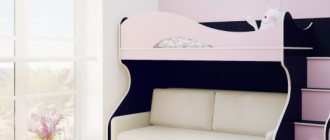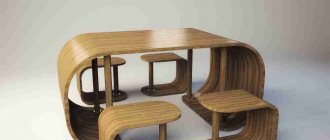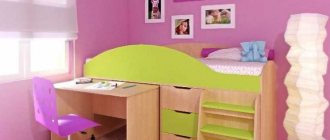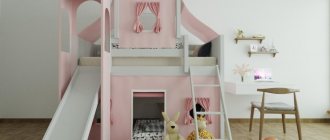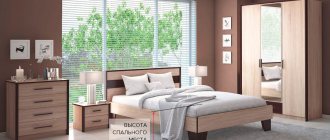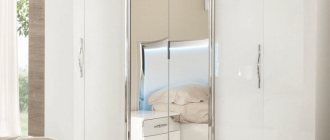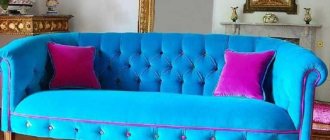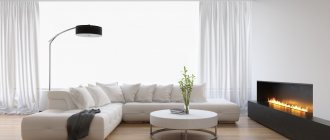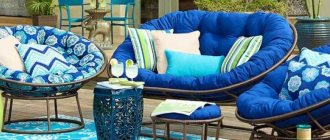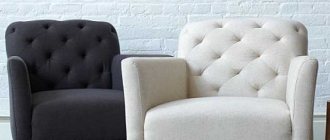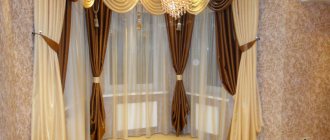Even before the most important event happens in the family - the birth of an endlessly beloved and dear baby, the first concern of parents is arranging the children's room. Already at this stage, the main task of future mothers and fathers is to purchase a cozy and high-quality crib. The modern market for children's goods offers many options for organizing a sleeping place for newborns; a children's bed with a pendulum is in considerable demand among parents.
Crib with a pendulum swing mechanism - advantages and features
At first glance, a pendulum bed is very similar to a traditional crib; the key difference is the presence of a special device that creates oscillatory movements. The legs of the crib remain motionless, only the berth rocks, maintaining a horizontal position.
The pendulum mechanism imitates motion sickness in mother's arms, the baby quickly calms down and falls asleep. Thus, a bed with a pendulum mechanism simultaneously functions as a berth and a cradle.
A crib with a pendulum mechanism is characterized by a long service life and can be used as a sleeping place from the very birth of the child until he reaches 3-5 years of age.
The positive qualities of pendulum beds also include:
- smooth ride;
- silent operation of the pendulum;
- presence of a movement blocker.
Parents can fully appreciate the benefits of the pendulum system at night. To calm a cranky baby, a mother does not need to jump to her feet at night; it is enough to simply touch the crib located next to the parents with her hand, thereby starting the pendulum.
What is a pendulum crib
A pendulum is a mechanism that is installed on a crib during its production and allows you to swing the berth, while the legs remain motionless.
Thus, a pendulum crib equipped with such a mechanism is capable of moving almost independently, with minimal effort from parents, and calming the child, creating a semblance of the natural motion sickness he is accustomed to.
Design and types of pendulum mechanisms for cribs
The structural elements of the pendulum are bushings, hinges, and a pendulum bar. There are models of cribs on the market with three types of pendulum mechanisms:
- longitudinal;
- transverse;
- universal.
The mechanisms differ in the swing trajectory. The longitudinal system creates oscillations of the bed from the head to the legs (back and forth), the transverse pendulum swings the crib in the right-left direction, the universal pendulum mechanism can make both longitudinal and transverse movements. Depending on the model, the vibration amplitude of the sleeping place ranges from 5 to 15 cm.
According to doctors, the best choice is a pendulum bed for newborns with longitudinal swing; vibrations in the back and forth direction are closest to human physiology. Oscillations along the body maintain normal intracranial pressure in the baby.
According to the method of swing, manual and automatic pendulum beds are distinguished.
A pendulum bed with a manual mechanism is activated by pushing the human hand. The oscillations of the sleeping place continue for about 10 minutes.
In electric models, a drive unit is used along with the pendulum mechanism to create oscillatory movements. The drive mechanism is a miniature electric motor equipped with electronics. The power source for the electric drive is the electrical network. The drive unit is mounted on the stationary part of the crib.
The pendulum mechanism can be controlled remotely using a remote control. In some models, a microphone is built into the drive unit; the bed with automatic electronic rocking is activated when the baby cries. After receiving a voice command, the electric drive starts the pendulum. The rocking cycle lasts for 10-15 minutes and the sleeping time stops automatically after the specified time has elapsed; if necessary, the movement of the crib can be stopped manually.
Pendulum bed
For a woman carrying a baby under her heart, it will not be a discovery that a child within 9 months gets used to constant shaking and motion sickness. He is able to relax and fall asleep in such an environment, while feeling peace and tranquility. After birth, using a pendulum crib will help you easily adapt to a new place to sleep. Light motion sickness will allow him to feel the same comfort of intrauterine life. When the baby grows a little and learns to stand up, the crib mechanism should be fixed to avoid injuries.
Speaking about the disadvantages, it is worth noting first of all that the cost of these is much higher. In addition, many children, getting used to falling asleep during motion sickness, being at a more conscious age, simply cannot fall asleep on their own.
Often the mother prefers to put the baby next to her, since this leaves more time for sleep. For such mothers, there are new types of cribs - with attachment to an adult bed.
General rules for choosing cribs
For many mothers and fathers, the decisive factor when buying children's furniture is visual appeal, however, this approach is fundamentally wrong. The main selection criteria are the convenience and safety of the little man. There are many things to consider when choosing a crib, including:
- material of manufacture;
- baby protection elements;
- features of the sleeping place arrangement.
Shapes, materials and sizes of frames
One of the main structural elements of a crib is the frame. Today, furniture manufacturers offer a huge selection of cribs for newborns; the range includes traditional rectangular models and somewhat non-standard products with a round or oval frame.
The strength and durability of a crib directly depends on the material used. In the production of furniture for small children, natural wood, MDF, plastic, laminated chipboard, and metal are used.
Of course, for a baby it is better to choose a crib made of natural material. Furniture with a wooden frame looks expensive and presentable, is characterized by a long service life and the ability to “breathe”. In the segment of wooden children's furniture today you can find quite affordable models; budget options include products made from pine, spruce and birch. More durable, expensive cribs are made from hard trees - beech, ash, oak. Wooden cribs vary in style and design. The market offers classic models made from unpainted wood and wooden cribs coated with paint and varnish, decorated with printed images.
Plastic frames are easy to maintain; the weight of a plastic crib is much less than its wooden counterpart. The affordable cost of plastic furniture also attracts buyers.
Before buying a crib for a baby, do not hesitate to ask the seller for quality certificates for materials. Unscrupulous manufacturers may use low-quality materials that are harmful to children in order to reduce the cost of furniture. To cover the structural elements of the children's bed, non-toxic, safe, water-based paints should be used.
Metal frames are famous for their strength and long service life. However, metal cribs are not widely used due to the “coldness” of the material.
The standard dimensions of a domestically produced baby crib are 120x60 cm. In imported products, the width and length of the sleeping bed are increased by 5 centimeters and amount to 125x65 cm.
Sides - types and rules of choice
Another important element is the sides of the crib; the main purpose of the design is to protect the baby from falling. The sides can be:
- stationary and removable;
- blind rack or combined (two solid sidewalls, two rack).
Most often, furniture manufacturers make the side walls of the sleeping bed in the form of a lattice structure; the side walls consist of a frame and cross bars installed at a certain distance. The crossbars can be made in the form of a round rod or be represented by wide slats.
When choosing a sleeping place for a baby, it is important to take into account two main requirements for enclosing structures:
- the distance between the vertical slats of the side parts should not exceed 5-6 cm;
- The height of the sides should be at least 60-65 cm, measurements are taken from the mattress to the edge of the side.
Additional protection for the baby will be provided by special silicone pads on the edges of the side and soft removable sides fixed around the perimeter of the crib. Elements of protection are especially relevant when the baby begins to actively move and during the period of teething. Silicone pads will not only protect the child’s gums from damage, but also maintain the integrity of the tree.
Some models of cribs are equipped with a front folding side. The folding sidewall allows you to move the child's bed close to the parent's bed; when the child grows up, he will be able to independently climb into his sleeping place. Unlike cribs equipped with runners to adjust the height of the side, folding designs use piano hinges. If necessary, the side can be folded down to the outer side and, when raised, is secured with latches.
Sleeping place - types and arrangement of bases
The base for the mattress of a baby crib can have a solid covered or slatted bottom. A solid bottom is considered more durable, and the cost of cribs with a solid base is lower than their slatted counterparts. A significant drawback lies in the design features; the solid base does not have gaps or holes, and therefore there is no air circulation between the mattress and the bottom. The mattress does not dry well and can quickly become unusable.
The slatted bottom consists of transverse strips fixed to the frame. The lattice design does not retain moisture inside the mattress and provides intense air circulation. The slatted base helps to properly distribute the load on the baby’s fragile spine.
Procedure and necessary tools for making a crib yourself
Bed headboard size chart.
Before you begin making a crib, you need to evaluate your existing toolset. And if something is missing, it is better to take care of purchasing them in advance.
- Hammer.
- Roulette.
- Level.
- Jigsaw, the best option would be the electric one.
- Sander.
- Rasp.
- Woodworking tools.
- Any version of a milling machine and a set of cutters for it.
- Electric drill and drill bit set.
- Weight - will be needed to fasten the parts of the crib.
That's all for construction tools, but there is a separate list for materials. It includes:
- Edged board (40 mm). It is better if it is a coniferous tree.
- Beam (50x30 mm).
- Oak or beech slats (20x20).
- Glue, preferably epoxy.
- Self-tapping screws.
- High quality varnish for covering furniture and stain.
- Plugs.
- Corners for furniture.
- Plywood (3-4 mm).
- Nails.
If you have already purchased all this, then you can start making a crib with your own hands.
To determine the size of your future crib, you need to focus on the mattress.
Tools for making a baby crib.
The standard size of a mattress for a crib is 1200x600 mm.
This means that the sides of the crib will be located at a height of 900 mm from the floor. The back of the crib will be slightly higher - 1100 mm.
So that the child, when he grows up, can climb into bed independently, the height of the sleeping place should not exceed 340 mm. And one more important point: the vertical slats of the end and side walls of the crib must have a gap of more than 120 mm.
Only in this case will the child be safe, since he will not be able to put his head between the slats.
The process of making a children's bed begins with the manufacture of strapping parts for the transverse side and end walls. The boards are processed using hand tools or on a woodworking machine. Their width should correspond to 7 cm and thickness 3.5 cm.
- the frame for the mattress will be made of bars. For a standard size, you will need 6 cross bars;
- it is necessary to glue the frame parts using a clamp, and it is very important to ensure its squareness;
- Then you can start making the backrest for the crib. Its size is calculated using the following formula: to 60 cm, add the value of the double thickness of the side parts and plus another 2 cm. Everything is quite simple. Next, the back frame is assembled onto a 3.5 cm spike;
- to calculate the length of the transverse parts of the back, it is necessary to subtract the width of the bed leg, multiplied by 2, from the width of the back, and then add double the size of the tenon;
- to make slats for the crib, use slats. As noted above, it is very good if they are made from wood such as oak or beech. Next, the planks need to be connected to the transverse parts using a blind single tenon;
- After the headboard frame is assembled (without using glue), you need to measure the length of the slats. To the length that we got, we need to add 2 more values for the length of the spikes.
Please pay attention to the requirement for the quality of the crib, such as the absence of sharp parts, corners and burrs. Grind the rods very carefully, and all corners must be rounded using a special cutter. All these steps must be completed before you begin assembling the bed parts.
Additional equipment for children's beds with a pendulum
Today, multifunctional furniture is valued, which allows you to optimize space as much as possible. Modern cribs for newborns can be combined with storage systems, a changing table, etc. Storage systems are represented by drawers and cupboards located at the bottom of the crib or on the sides of the bed.
Crib with transverse pendulum
These cribs are perfect for those who count every square meter, because they take up less space than the previous model.
Another advantage is their autonomy: upon waking up and tossing and turning in their sleep, the child sets the crib in motion, and it begins to rock, thereby lulling the baby to sleep. But children learn to roll over only by 3 months. This option is very convenient for mothers, because they don’t even have to go near the crib.
How to assemble a bed with a pendulum with your own hands - step-by-step instructions
You can assemble a bed with a pendulum yourself. At the first stage of work, you should prepare the necessary equipment, unpack the crib, carefully read the assembly instructions, and check the presence of all structural elements and fasteners.
It is better to assemble the crib at the place of its use.
Work equipment includes the following tools:
- reversible key;
- screwdriver;
- hammer;
- screwdriver
Work order:
- The rear fixed wall of the crib is placed on the floor with the inner side up, the side parts are mounted using screws;
- install the base under the mattress, placing it in the provided grooves and securing it with screws;
- the front movable part of the crib is inserted into the guide grooves located on the side parts, using screws the free edge of the base under the mattress is fixed to the front wall;
- start assembling the pendulum:
- assemble the supports with pendulums, connecting four components to each other;
- hinges are secured to the pendulum bars using washers and bolts;
- Using nuts, secure the hinges to the base of the pendulum device. The nuts are seated on the washers without tightening them all the way;
- The body of the children's bed is installed on the support with pendulums, the structure is fastened by installing bolts to the legs, and the side part is fixed with screws;
- install the bearing mechanism and clamps;
- The screw fastening areas are covered with plugs.
Video instructions for self-assembling a crib with a pendulum mechanism:
Types of pendulum beds and their features
Like almost any type of bed, pendulum beds have many different shapes and configuration features. Let's look at their main varieties.
Shape: rectangular, round, oval
As a rule, cribs are rectangular in shape. However, recently, cribs of round and oval shapes have begun to gain popularity.
The diameter of round cribs usually does not exceed 90 cm, that is, they are intended for children from birth until 3-6 months, after which the crib needs to be changed. Often, round cribs are transformable and when the child reaches a certain height, they easily lengthen, turning into oval ones.
Photo: Pendulum crib and its varieties (by shape)Oval shapes do not have any special advantages over rectangular ones and are usually a kind of “item of status”. Such cribs are not very convenient to place against a wall; as a rule, they look more beautiful and organic in the center of a child’s room. You should also keep in mind that the cost of mattresses and linen for round and oval cribs is slightly higher than the cost of similar products of standard rectangular shapes.
By type of pendulum: manual, automatic
The easiest way to rock is manually, and the pendulum mechanisms are triggered even by a slight push and, by inertia, rock several more times, which may well be enough to put a baby to sleep if he wakes up in the middle of the night.
Mom doesn’t even need to get out from under the blanket for this. This significantly saves the mother’s energy during long periods of rocking the baby.
An electric pendulum does the same work, but without human intervention. Some automatic pendulums have sound sensors and turn on when they “hear” that the child has begun to wake up. However, this function is not always convenient, since the mechanism cannot distinguish the place of origin of the sound and can rock an empty crib for 15-20 minutes just because a screaming child just ran past.
More convenient are programmable automatic pendulums that are turned on by parents with a preset motion sickness program, after which the pendulum itself will turn off without disturbing the child’s sleep.
According to completeness: without drawer, with drawer, with chest of drawers
Many cribs have additional equipment, for example, under the berth there can be runners for a retractable linen drawer, in which you can also store toys and other children's things.
Some models have built-in children's chests of drawers with changing tables. This “hybrid” is very convenient to use and allows you not to waste money and effort on finding additional children’s furniture that matches the style and size. However, please note that these beds will be equipped with a transverse pendulum.
The simplest cribs do not have changing tables or cabinets, however, parents can independently add suitable size drawers, chests of drawers and other necessary items to the crib.
Mobility: on wheels, without wheels
Most cribs are equipped with wheels with locks, and some cribs, in principle, cannot be used without wheels. Cribs with legs (without wheels) are also found and, as a rule, belong to a lower price segment.
However, the presence of wheels is not so necessary: anyway, the crib spends most of its time with fixed wheels, which is not fundamentally different from a crib simply installed on legs.
Difficulty: transformable bed with pendulum
Transformer beds, as a rule, have a whole set of additional parts and even types of furniture that can be used by both a baby and an older child. Often, such a crib first has the size of a cradle, then it is extended into a crib with a side, and for an older baby it turns into almost a full-fledged bed.
Photo: Transformable bed and options for its transformation
Such cribs can also be equipped with a pendulum mechanism, of course, in configurations designed for the little ones.
According to bed size
The standard size of a sleeping place for babies is 120x60 cm. Larger cribs are less common - 140x70 cm.
The same dimensions are used by textile factories when sewing children's bedding.
But demand creates supply, and the widespread use of round and oval cribs has led to the emergence of other bed sizes:
- round with a diameter from 65 to 90 cm, with the most popular diameter being 75 cm;
- oval with dimensions from 90x60 to 125x75 cm.
Photos of children's beds for newborns with a pendulum mechanism
<
>
Pendulum selection criteria
When choosing which pendulum is better - longitudinal or transverse, you should pay attention to the following aspects:
- the location of the mother relative to the crib during rocking;
- the size of the room where the child’s bed is located;
- baby's reaction to different swing directions.
It is more convenient to rock the crib in the direction away from you - towards you, rather than left and right. Therefore, if the place for mom is located on the side of the crib, then it is better to choose a transverse pendulum, and if at the head, then a longitudinal one.
If there is plenty of space for a crib in the bedroom, then you can afford to install a crib with a longitudinal pendulum, and if the room is small, then a transverse pendulum is recommended.
As for the baby’s reaction: it can only be known if the pendulum is universal. You need to observe how the baby falls asleep while swinging in each direction, and determine which is better for him - longitudinal or transverse. But this selection criterion is unreliable, because many different factors (for example, well-being) can influence how a baby falls asleep.
How to choose?
Choosing a suitable crib with a pendulum mechanism for a newborn is a very responsible and important moment. When choosing a design, parents should take into account several important nuances. At the same time, the aesthetic appeal of the product does not play the most important role.
It is very important that the bed is comfortable, cozy and does not pose any danger to the child’s health. Therefore, when choosing a suitable crib model, you need to pay special attention to the material from which it is made; the presence of reliable and durable protection elements on the structure; features of the case.

